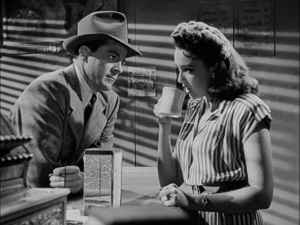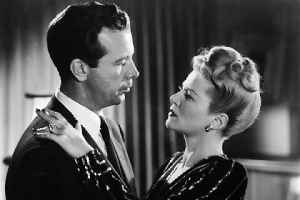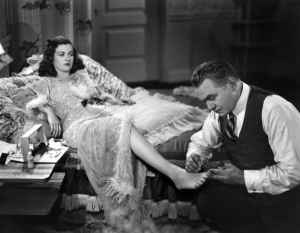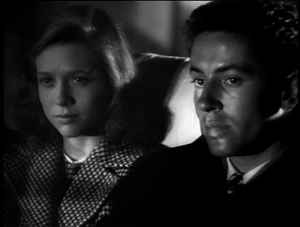Four Film Noirs You Might Not Have Seen
Film noirs is still a popular genre even after its peak in the 1940s and 50s. A typical film noir narrative consist of either an investigation, characters on the run for various reasons or illicit relationships gone awry. No matter the narrative, film noirs usually have intriguing characters whose motives audiences continuously question. Sinister characters inhabiting seedy environments, where tragedy is inevitable. Scenes typically containing expressionist use of mise en scene, wherever it be a style of lighting or non-diegetic music provoking audiences’ emotions. Film noir always results in a memorable viewing experience. Double Indemnity, Gilda, Laura and The Big Heat are some of the many film noirs that have been regarded as classics. However there are more film noirs which equal these examples or even subvert them, yet are not as well-known.
4. Fallen Angel (1945)

Fallen Angel portrays Walton as a town with underlining corruption, where drifter Eric Stanton unwittingly becomes involved. Eric enters the local cafe, the scene of Walton’s social vibrancy, where he becomes transfixed by Stella the waitress. Eric’s immediate attraction to Stella leads to a dangerous relationship, where he is willing to do anything for Stella’s love. However, Eric finds himself in danger after being wrongly accused of Stella’s death.
Fallen Angel is memorable for its subversive use of mise en scene. Film noirs are usually set in urban locations filled with bustling nightlife. Walton is a picturesque town where residents converse in cafes, dance halls and quiet spots. It is a complete contrast to standard film noir mise en scene. As with Blue Velvet forty years later, Walton’s aesthetics in contrast to the immoral activities of some residents makes for enthralled viewing. Eric and Stella have common ground, both searching for their vision of a perfect lifestyle. It becomes somewhat appealing to see these fragile figures mixing together in immorality. Yet June, less tainted than Stella, gives Eric a new dimension to his character. Fallen Angel‘s use of June as a moral woman to act as a counter balance for Stella makes it a film noir with a difference. June guides Eric through her morality, making him question where his life is leading. In film noirs, characters like Eric usually meet a tragic end. It is rare for such characters to be given a second chance. Fallen Angel offers a different dynamic where Eric becomes redeemed through June, whose kind and loving personality gives Eric a new, unadulterated existence.
Once the murderer is revealed as a Walton resident, Fallen Angel‘s pessimistic view of amorality within society is accumulated. It reflects how Eric’s infatuation with Stella could have gone if it had reached extremes. This reflective realisation along with Eric drifting between immorality and morality makes Fallen Angel a provocative character piece.
3. Murder, My Sweet (1944)

Murder, My Sweet shows Detective Marlowe investigating the whereabouts of a woman known as Velma. Marlowe soon finds himself caught in a dangerous mystery, contending with multiple motives.
A strong point of Murder, My Sweet is Helen’s character, a manipulative woman of many secrets who embodies herself as a classic femme fatale. Helen’s introductory scene reflects these qualities due to Claire Trevor’s versatile acting. Marlowe is led to Helen’s residence where she presents herself in a silent yet appealing manner. Whilst Helen isolates herself by sitting in a corner of a room, she is able to make prominent use of her legs to gain Marlowe’s attention. Trevor’s acting could also make Helen extremely obvious in her intentions, shown in a later scene when Helen visits Marlowe in an attractive black dress. “Don’t mind me sizing you up?” Helen asks Marlowe, clearly indicating her true motives. Trevor’s versatility enhances Helen’s femme fatale persona as cunning and exploitative.
Another interesting feature in Murder, My Sweet is Marlowe’s representation. He is not the typical private eye whose gritty and self-assured. Instead Marlowe as a private eye is rather light-hearted and easily intimidated. At the beginning of Murder, My Sweet, Marlowe is obviously intimidated by a client and initially attempts to end the conversation. Only through the client’s physicality does Marlowe comply. In a later scene Marlowe is threatened by another client and replies, “I tremble at the thought of such violence”. Could you ever imagine Bogart or Mitchum in this role?
2. Scarlet Street (1945)

Scarlet Street shows pathetically naive and emasculated Christopher Cross becoming mislead by Kitty for a money-making scheme. Christopher as a talented artist paints portraits, which Kitty soon manipulated credit for. However, Kitty’s actions lead to a dark ending.
Like Claire Trevor, Joan Bennett’s portrayal of Kitty should be recognised as a memorable femme fatale. Bennett embodies an intensity in her performance to reflect extreme sides of Kitty’s personality. Kitty is overtly sexual with Johnny, allowing audiences to understand her manipulative attitude through her supposed innocence with Christopher. Her vulnerability around Christopher underlines her sarcastic innocence, reflecting the power within Bennett’s performance. Though credit also has to be given to Edward G. Robinson, an experienced character actor who is able to perfectly convey Christopher’s timid nature. The longer Kitty’s deceit continues her inevitable revelation to Christopher as a femme fatale would be equally powerful and antagonising. “I’m laughing you fool!” she exclaims at Christopher’s horror once her true self is revealed.
The resulting tragic climax stemming from Kitty’s deception of Christopher is extremely bleak. This is due to the fact that Christopher, as the true victim, continues to suffer. After Christopher kills Kitty, her boyfriend Johnny is wrongly convicted and executed. This causes Christopher to suffer from extreme guilt. He cannot claim ownership of the portraits he painted, which are acclaimed as part of Kitty’s legacy. If this irony is too much for Christopher to bear, he becomes haunted by visions of Kitty and Johnny mocking him. Christopher’s life will forever be plagued with guilt and inferior self-perception. Although Christopher is the victim, in a sense he is the one who is ultimately punished rather than redeemed like in typical film noir. leaving Scarlet Street lingering in the audiences’ memory.
1. They Live By Night (1948)

They Live by Night‘s emotionally powerful storyline and moody atmosphere reflects what film noir is known for. Yet it reflects the tragic story of two young, naive lovers instead of hardened criminals. Misfit Bowie is forced to survive through robbing banks with experienced accomplices ‘One-Eye’ Chicamaw and ‘T-Dub’ Mansfield. Bowie meets a similar naive soul in Keechie, who nurses him back to health. The pair quickly develop a bond that leads to a run-away romance. However, their relationship is always threatened by a continuous struggle between love and criminality.
They Live by Night goes beyond action-packed violence, tense confrontations and atmospheric settings. Instead They Live by Night focuses upon complex relationships with stirring emotions. These relationships in a harrowing situation results in a bittersweet viewing experience, partly due to Bowie and Keechie’s chemistry. Both contain a sense of nativity and innocence within their love for each other. Despite Bowie’s reputation for his criminality, his true self is revealed; a young man engulfed in misdeeds attempting to escape. Although Keechie is vulnerable and inexperienced in Bowie’s world, she still loves him wholeheartedly. Bowie and Keechie’s journey is heart breaking to see.
They Live by Night’s tragic and fierce attributes went beyond characterisation though appropriate symbolism, adding to Bowie and Keechie’s dire circumstances. In a memorable scene where Bowie and Keechie marry, it takes place at a cheap chapel with a cost of $20 for the wedding license. This cheap tackiness is associated with the social background Bowie and Keechie are attempting to escape, trying to lead suitable lives yet sinking so low to achieve it. This underlines a depth towards They Live by Night‘s narrative, surpassing into a fully charged emotional noir as its generic nature focuses upon a tragic love story rather than an amoral demise.
The lesser known film noirs mentioned above deserve to be held in the same esteem as the classics. They contain effective use of generic motifs, such as Claire Trevor’s and Joan Bennett’s portrayal of a femme fatale. These films are also subversive towards generic motifs, like Walton’s picturesque setting masking as a place of deceit and Bowie and Keechie’s youthful nativity being the focus point of a film noir narrative. No matter how these film noirs present themselves, they all contain an intensity which should place them in higher esteem within their genre.
What do you think? Leave a comment.











I love film noir! I’ve seen all the big ones but none of these. I’ll be sure to add these to my watchlist.
I totally need more film noir these days. Probably my favorite noir is the classic Chinatown with jack Nicholson.
Fritz Lang’s masterpiece M constantly gets overlooked, but it needs recognition. It’s the true inventor of film noir.
I believe its because M is considered part of German Expressionism, which came before Film Noir. However as a counter point, German Expressionism influenced Film Noir. So M could be seen as an early example of Film Noir.
A few favourites off the top of my head:
Laura
Out of the Past
In a Lonely Place
Maltese Falcon (surely acknowledged as the first and one of the greatest noire)
Ossessione (Visconti’s 40s version of The Postman Always Rings Twice)
Brick
The Strange Love of Martha Ivers
Laura, Maltese Falcon and Out of the Past are better known in the Film Noir genre. Whilst Ossessione is seen as an early example of Italian Neo-Realism. Though I would agree with the remainder of your list not being as well known.
Great post. I give my thumbs up for Out of the Past. Seems to have been forgotten these days, but if you ever had to teach a course on film noir and choose a perfect illustration, it would have to be this one.
The plot gets needlessly twisty and turny towards the end though.
Amazing dialogue too. Brilliant voice over. And has the ultimate noir lines which capture pessimism of the genre brilliantly, when Cathy and Bailey are playing roulette:
That’s not the way to win
Is there a way to win?
There’s a way to lose more slowly…
I think the ultimate noir is Double Indemnity though. Because of the rain and the shadows, the brilliant dialogue, the angel of death femme fatale, and the utterly doomed cynicism. It’s got everything. Build My Gallows High next though.
LA Confidential. Apart from being a film noir, it`s one of the best all time movies.
The list of my top ten film noir is as follows:
1. Double Indemnity (1944).
2. The Big Sleep (1946).
3. L.A. Confidential (1997).
4. The Maltese Falcon (1941).
5. A Touch of Evil (1958).
6. The Third Man (1949).
7. Farewell my Lovely (1975).
8. The Big Heat (1953).
9. The Postman Always Rings Twice (1946).
10. Woman in the Window (1944).
Compiling the above list was a straightforward affair. I take Double Indemnity to edge out, very marginally, The Big Sleep, but in all honesty it is unclear how one can separate two masterpieces of their level of perfection. LA Confidential is a personal favourite, and I hugely admire Robert Mitchum as Philip Marlowe in Farewell my Lovely (as I admire him in general and in all his films). The other selections would appear to pick themselves. Cagney films do not seem to me to count as belonging to the film noir category proper, but it was good to have two films apiece with Bogart and Orson Welles. I regret that I could find no place for Chinatown and likewise for the masterly comic take by Truffaut on the film noir genre in his brilliant Vivement Dimanche (1982) – another personal favourite.
This is a finely chosen list. Le Samourai perhaps deserved to squeak in?
The Man Who Wasn’t There.
Dick Powell’s Fairwell My Lovely (Murder, My Sweet)
There’s a fabulous drugged-out sequence in the film
Robert Mitchum did a pretty good remake of it in 1975
Hell is a City (1960) by Val Guest is a great British noir.
Very nice review of some films I have not seen. Thank you
Thanks Venus
So many great noirs…
Stray Dog!
Come on, this list needs Kurosawa!
The Postman Always Rings Twice
I think that The Spy Who Came in from the Cold would qualify.
As far as Neo -Noir, I will go for Night Moves with Gene Hackman (1975)
Excellent choices!
Does Citizen Kane count as Film Noir?
How about Siodmak’s The Killers, just for its brilliant opening scene or Edward Ulmer’s Detour? The Postman Always Rings Twice (original) is worth a mention.
Those film noirs are well known. I was focusing on film noirs which are lesser known.
The Killers is a great choice. The unusual plot by showing the end first is great. The other 2 that you mention are great too.
Beautiful choices.
The Last Seduction, and Malice, are both pretty good newer noir.
Interesting list that differs from the usual great classics of films noirs. This genre is so often reduced to its very famous successes but it is worth looking into it more.
Definitely Edgar G. Ulmer, as noted above (“Detour”). Also, the original “D.O.A.” by Rudolph Mate. How about “Blood Simple” by Coen Bros.?
The year prior to making “Scarlet Street” (1945), its director, the celebrated German expressionist Fritz Lang — he having fled to the States after the Nazis came to power in the mid-’30s — had collaborated with Robinson, Bennett and second lead Dan Duryea on “The Woman in the Window.”
Thematically, the films are very similar. In both, Robinson is a lonely middle-aged man who becomes involved by chance with criminal types Bennett and Duryea. Despite a hokey ending imposed by the production code office — Robinson’s character is revealed to have literally had a nightmare, inventing the film’s proceedings therein — “The Woman in the Window” is a more memorable film than its successor, “Scarlet Street”. The former film is considerably less melodramatic, focusing on building up the tension instead. And “The Woman in the Window” also benefits from the reliable and welcome presence of character actor Raymond Massey, who plays Robinson’s district attorney friend. Both films are not as well remembered as they should be, but given the choice between the two, I’d pick “The Woman in the Window” over “Scarlet Street.”
A stray observation about “Murder, My Sweet” (1944): It is based on Raymond Chandler’s novel “Farewell, My Lovely” and that is the title the producers of the film intended to use. But then Dick Powell was cast as detective Phillip Marlowe, Powell heretofore known as a star of lightweight musicals like “Gold Diggers of 1933” et al. With a title like “Farewell, My Lovely,” it was feared that audiences of the day might not understand the film’s subject matter. So the change was made to “Murder, My Sweet,” thus avoiding any possible confusion.
I love love love Scarlet Street! My favourite Bennett-Lang’s film! I think Joan Bennett is the perfect femme fatale in this one. Of course, Claire Trevor is perfect too in Murder my Sweet.
Great article!
These sound interesting: I have only heard of Fallen Angels before. Particularly the second movie covered.